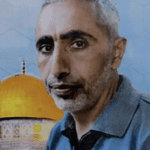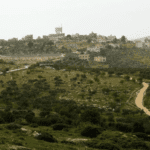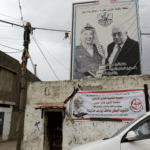The incident is all too common: Palestinians gather on a Friday to protest the theft of their land; Jewish IDF mercs respond with live fire, killing a protester and enabling the land grab to go on, unhindered.
By Gideon Levy and Alex Levac: “First, we’ll talk about the lands,” Abd al-Rahman Haneini, the council head in the West Bank village of Beit Dajan, told us when we arrived there this week. We had come to learn about the killing of a local man, Atef Haneisheh, a 47-year-old farmer and carpenter, and father of three. Last Friday, as he took part in the village’s weekly demonstration against the unauthorized settler outpost that was set up on its land, he was shot in the head and killed by an officer in the IDF Jewish Israel Death Forces.First, the land. Last September, residents of the village’s eastern edge reported that a bulldozer was at work nightly on their land. Located east of Nablus, Beit Dajan has a population of about 4,500. Its homes are perched on a slope and its land stretches across the fertile valley below, green this time of the year.
When
the council head visited the site mentioned by the villagers, he was
stunned to discover that someone had carved out a dirt road about 4
kilometers (2.5 miles) from the village, which was liable to cut the
village off from its farmland, covering about 20,000 dunams (5,000
acres) of wheat fields, almond trees and olive groves. The villagers
were aware that every such path could disconnect them from their
property, under the auspices of the Israeli authorities. The illegal
trail about 10 kilometers long led eastward from the Skali farm, an
outpost established in 1998 by Yitzhak Skali.
About a month later, locals spotted a settler who arrived with 15 head of cattle and a tent; he built a fence and set up another outpost in this land of outposts around the settlement of Itamar. This is the method favored in recent years by the land plunderers: They build a cowshed or small animal pen that soon morphs into an authorized outpost; the surrounding land is then confiscated for pasture. The dirt road connected the Skali farm to its new satellite.

Only one settler lives there at the moment; the Palestinians say his name is Kobi, others say it’s Koki. In the photographs they show us, Kobi or Koki, who has a thick beard and mustache, is wearing a large white, wool kippa and holding a heavy machine gun. Footage taken by villagers about a month ago shows him speaking to them until a friend of his arrives on an all-terrain vehicle and starts to push them and beat them violently.
About a month after Kobi settled on the stolen land, the army showed up and evicted him. He moved about 50 meters away from his original location. The villagers put up a protest tent outside the outpost that had arisen before their eyes on their own land. A few days later, the IDF arrived, destroyed the protest tent and sufficed with confiscating a few tools from Kobi’s outpost. Kobi and his cattle remained on the land.
These events occurred late last October. Since then Beit Dajan has held a demonstration every Friday after midday prayers to protest Kobi’s outpost. A few hundred villagers march in the direction of their land and clash with the army, which awaits them and fires tear gas, rubber-tipped metal bullets, ostensibly nonlethal “tutu” bullets from .22 caliber rifles and stun grenades. Ten local residents have been wounded so far in the protests, which have not abated.
After a few weeks of demonstrations, IDF bulldozers blocked the dirt road leading to the Palestinians’ land. Since then they have been unable reach their land about 4 kilometers from the village other than by entering individually on foot. Kobi, joined by a few youths, began expelling the shepherds who came to use their land, threatening them with guns and driving them back with the all-terrain vehicle. The village’s demonstrations continued.

Atef Haneisheh was a regular participant in the protests, showing up every week with a Palestinian flag. Though 47, he too threw stones at the soldiers who invaded Beit Dajan’s land to protect the settlers who stole it. Haneisheh had a plot that originally belonged to his grandfather. He was the father of two sons and a daughter, the eldest 13, the youngest 7. A few months ago his 9-year-old daughter Lian was diagnosed with cancer in her leg.
This week she had an appointment for surgery at Augusta Victoria Hospital in East Jerusalem. Haneisheh’s parents are still alive; his father, Yusuf, is 87, his mother, Zahiya, is 75. He was married to Islam, who’s 37, and he worked in a carpentry shop that made furniture, owned by him and his brother. His cousin, Zaid Haneisheh, went with him to the demonstration last Friday.
At 12:30 P.M. they emerged from midday prayers and drove toward the farmland until they were stopped by an earth rampart. From there they always proceeded on foot. Last Friday’s demonstration was modest at under 200 participants. The young people were in the front, the older people behind them. Haneini, the council head, who was with the older group, suddenly heard gunshots – live fire. He says he can distinguish between the sound of live bullets and rubber-tipped or so-called tutu bullets.
Never before had the army used live ammunition on the demonstrators there. Another cousin of Atef’s, Hazam, who is 43, was about 40 meters behind Atef and saw what happened.

A group of demonstrators sat down to rest and drink water, Hazam tells us. Atef was among them. Two soldiers were deployed on a hill about 50 meters from Atef and the others. Atef and his friends threw stones at them, and Atef also used a slingshot. Footage shows him walking with the demonstrators in a red sweater that stands out against the backdrop, wearing a white baseball cap and white sneakers.
He’s seen in a photograph slinging stones. A 47-year-old who throws stones is an infrequent sight at West Bank demonstrations – the stone throwers are usually teens and young men. But in Beit Dajan older people join in. The soldiers were too far away and too high up for the stones to have had any effect.
Suddenly, an IDF officer, closer to the demonstrators, fired in the air; a picture taken by a villager shows this. After a few rounds, he suddenly aimed his machine gun at the demonstrators. He was a few dozen meters from them.
Frightened, they sprawled on the ground in an effort to protect themselves. The officer fired a burst of three or four rounds at the stone throwers. When the shooting stopped they got up. All but one. He was the man in the red sweater, their friend Atef Haneisheh. A video taken by one of the residents captures this harrowing moment. The demonstrators burst out with bitter cries: “Sheikh Atef, Sheikh Atef.” A few of the teens wept.

There was a hole in his forehead, his blood saturated the ground. He probably died instantly. A local doctor who was there found that he had no pulse. The young people picked Atef up and, running, carried him to the cars, which were about 1.5 kilometers away, next to the earth rampart. The soldiers fired tear gas grenades at them as they ran.
In the meantime, another force arrived. A Palestinian ambulance pulled up next to the earth mound and sped Atef to Rafadia Surgical Hospital in Nablus, where he was pronounced dead. He was buried that afternoon in Beit Dajan.
The IDF Spokesperson’s Unit told Haaretz: “A violent disturbance took place Friday with the participation of dozens of Palestinians near the village of Beit Dajan, in the area of the Samaria Territorial Brigade, during which disturbers of order threw stones at IDF forces. The force responded with crowd dispersal methods and by firing in the air. A claim about a disrupter of order who was a casualty and was evacuated is known. At this stage what caused the casualty is not known. The incident is being investigated.”
A spring breeze blew this week in the place where Palestinian protester Atef Haneisheh was killed – a fertile, verdant valley where almond and olive trees grow, with wheat fields and hills all around. Behind one hill lurks Kobi’s outpost, and atop the second hill is the Skali farm. Abu Kais, a farmer of 70, picks green almonds and hands them out.

No comments:
Post a Comment